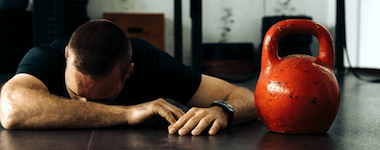Tomo has had AMAZING training from many different sources, one of which is Sharon Sauer (CMTPT). The following article by Sharon will give you ways to have a better, healthier work day. A healthy day, is a happy day!
Sitting has become such a large and unhealthy part of our daily activities, healthcare professionals have coined the term “Sittosis” to describe the range of health problems caused by this prolonged sitting. One of the major health concerns to address from all this sitting is the health of our lower backs. One muscle in particular is negatively affected by our sitting lifestyle and causes more than 50% of the low back pain cases seen by trigger point therapists. (1)
This “Sittosis” Muscle is called the Iliopsoas. Trigger points in the Iliopsoas cause pain in the most common place we experience low back pain – right along the side of the spine in the small of our backs, as shown in the illustration below. Trigger points in the lower region of the Iliopsoas can also cause pain in the front of the upper thigh, also commonly experienced. The low back pain from trigger points in the Iliopsoas can be so excruciating you may only be able to crawl on your hands and knees due to the severity.

If you’re life has accrued a lot of time spent in a seated position, whether driving, working or at home, perform the following quick tests and self-care tips to identify and correct possible trigger points in your Iliopsoas.
*The information in this article is not intended to diagnose or treat any medical condition and does not substitute for a thorough evaluation by a medical professional. Please consult your physician to determine whether these self-care tips are appropriate for you.
(2) Quick Self-Tests to Tell if You have Trigger Points in Your Iliopsoas:
The tests we illustrated for the Gluteus Maximus several issues ago are similar to the tests for the Iliopsoas. Follow the instructions below to test whether myofascial trigger points might be present in this vital low back and hip muscle.
TEST 1: Knee to Armpit Test – Tests the ability of the Iliopsoas to shorten


While lying on your back, bring one leg up toward your chest. Grasp behind your thigh (not over your knee) and pull your thigh up and as far as you can toward your opposite armpit. Keep your knee and abdominal muscles relaxed. A Passing result is when you can bring your knee quite close to your chest. A Failing result occurs when the knee remains further away from the chest (as shown). The further the knee is from the opposite shoulder the greater the amount of myofascial dysfunction and trigger points present in the Iliopsoas.
TEST 2: Seated Toe Touch in Chair

Sit in a stable and comfortable chair, lean forward, and reach toward your toes (as shown). A Passing result is being able to place your hands flat on the floor. If you can’t reach your hands flat on the floor, that is a Failing result, again indicating the likelihood of trigger points.
________________________________________
3-Step Simple Self-Care Remedies
Here are simple self-care remedies for treating myofascial trigger points in your Iliopsoas. Repeating these steps 2-3 times per day can greatly reduce and prevent low back pain.
Step 1: Warming Up with Moist Heat
To relax and warm up the fibers of the Iliopsoas, take a warm bath or use moist heat, such as a Fomentek bag over the abdomen and under the low back for 10-15 minutes.
Step 2: Compression

To compress trigger points in the Iliopsoas, lie on your side and lean over on top of a ball, as shown. Here we are using a 7″ therapy ball, but a child’s basketball slightly deflated or a even a mushy extra soft softball works, as well. Start with the ball on one side of your belly button (upper Iliopsoas). Lean over onto the ball with as much weight as is comfortable. Gently roll side to side a couple of inches over the ball, searching for tender spots in the Iliopsoas. When you find a tender spot, hold that position for 10 seconds. Then roll the ball a couple inches down toward the hip and repeat. Work your way down and finish when you are over front of your hip. Perform on both sides for best results.
Step 3: Stretching the Iliopsoas
The Iliopsoas is so important to stretch due to the extensive amount of sitting we do on a daily basis. There are 2 main stretches that will help greatly to get full range of motion and function back into the Iliopsoas.
Seated Stretch

Sitting on the side of a chair or stool, bring the leg back as far as you can comfortably extend it and keep the torso upright, as shown. You should feel a stretch in the front of the hip in the Iliopsoas. Hold for 20 seconds and repeat 2-3 times per side. Always perform on both sides to provide balance between both Iliopsoas muscles.

Contract and Relax the Iliopsoas
The second stretch / exercise involves shortening the Iliopsoas and contracting the opposite (antagonistic) muscles in sequence. Start by bring the knee up toward the opposite shoulder as far as it will go comfortably, as we did in Test 1 above. Hold that stretch for 10 seconds. Then gently press the knee outward against your hands and hold that contraction for 5-10 seconds. Breath in and then relax the contraction as you exhale, stretching the knee further toward the opposite shoulder again. Repeat this sequence 3-4 times. You should notice the knee gradually stretching further toward the opposite shoulder with each exhalation.
Perform these 3 steps daily and you will prevent some of the negative effects of “Sittosis”!!!
1Sharon Sauer, CMTPT, LMT and Mary Biancalana, CMTPT, LMT Trigger Point Therapy for Low Back Pain. P. 60. New Harbinger Publications: Oakland, CA 2010.


